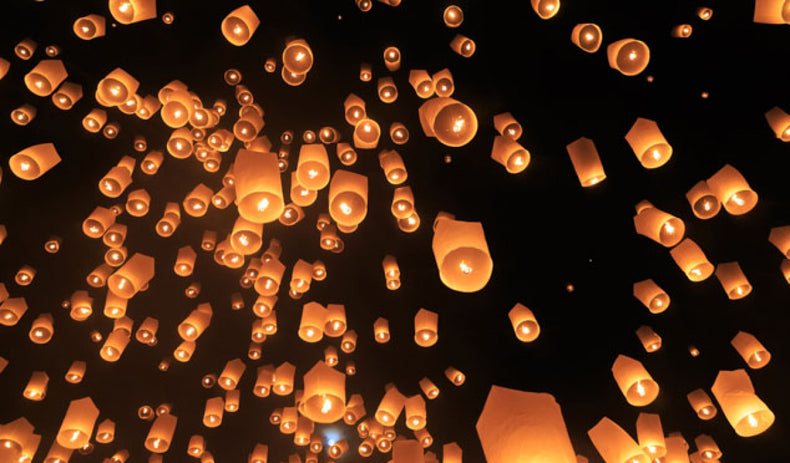Everything You Need To Know About The Chinese Mid-Autumn Festival

What is the history of Mooncake Festival?
Fascinatingly, in the rich world of Chinese mythology and folklore, there are various legends linked to the moon and to the Chinese Mid-Autumn Festival.
One legend tells of how ten suns appeared in the sky at the same time, scorching the earth with their combined heat. A heroic archer, Hou Yi, shot down nine of the suns. His wife Chang’e drank the elixir of life to keep it safe from his enemy and floated to the moon, living there, with her grieving husband lighting lanterns as a signal to her from earth.
A second moon legend concerns a lazy woodcutter Wu Gang, who so annoyed an immortal that he was placed on the moon and set to work chopping a perpetually renewing tree. A third legend tells of how three Chinese sages transformed themselves into pitiful old men and begged for food from the fox, the monkey and the rabbit. The fox and the monkey had food to give to them but the rabbit, with nothing to give, offered his own flesh instead, leaping into the flames to cook himself. So moved were the sages by his sacrifice, that they let him live in the moon as the Jade Rabbit.
And a third more down-to-earth legend stems from mooncakes (or moon cakes) as weapons of war. Towards the end of the Yuan dynasty (AD 1280-1368), when Mongols ruled China, a rebellion to overthrow them was concocted with messages hidden in the mooncakes which were sent as gifts from house to house. On the night of the Chinese Mid-Autumn Festival, so the story goes, the rebels acted, overthrowing the Mongol rulers and ushering in the Ming dynasty (AD 1368-1644), with mooncakes eaten ever since to commemorate this event.
How to celebrate Chinese Mid-Autumn Festival
Nowadays, as for centuries, the Chinese Mid-Autumn Festival is celebrated by families coming together to observe the full moon and give thanks for the harvest. As with all Chinese festivals, special, propitious foods are eaten to celebrate - from watermelon and taro to cakes and wine flavoured with fragrant osmanthus blossoms.
The best-known Festival food is, of course, the mooncake, which, with its round shape represents the full moon, and is eaten at this time of year. Mooncakes have been traced back to the Song dynasty (960—1279 AD) and came to be associated particularly with the Chinese Mid-Autumn Festival. Traditionally, families would bake mooncakes to give to family and friends.
Mooncakes classically consist of circular pastry shells filled with a sweet or savoury filling. Part of the culinary appeal of mooncakes is the contrast in textures between the shell and the rich-tasting filling. This is often red bean paste, made from cooked, sweetened azuki beans, which has a distinctive, slightly earthy, nuttiness.
Other traditional fillings include jujube (Chinese date) paste, five kernel (a mixture of nuts and seeds such as walnuts, peanuts, almonds, pumpkin seeds and sesame seeds), melon paste, ham or pork.
As one would expect in such a vast country, different regions of China have their own, specific moon cake traditions, with variations both in the texture of the shell and the filling. Cantonese mooncakes, for example, are traditionally filled with lotus seed or red bean paste with a whole preserved duck egg yolk in the centre, which, with its shape and rich golden colour, symbolises a full harvest moon. Beijing-style mooncakes are traditionally valued for their delicate flavours and careful decoration. Suzhou or Su-style mooncakes have a flaky crust, often filled with minced pork or black sesame seeds. Fillings nowadays range from luxurious seafood, such as abalone, to pungent durian.
A recent phenomenon is the rise of the chilled, non-baked, snow skin mooncake, originating from Hong Kong, in which a glutinous rice crust encases fillings flavoured with durian or chocolate. One can also find ice cream mooncakes, which in shape and pattern mimic traditional mooncakes but are made from ice cream, so, for example, a chocolate ice cream shell enclosing a filling of vanilla ice cream.
What is the significance of different mooncake designs?
One of the charms of mooncakes is that their pastry shells can be patterned by pressing them into moulds. So, mooncakes during the Chinese Mid-Autumn Festival might be decorated with images from legends associated with the moon, such as Chang’e and the Jade Rabbit. Flowers, such as chrysanthemum (which symbolises long life in Chinese culture), koi carp (symbolising prosperity) and a peach (symbolising longevity) are among the popular patterns used to decorate mooncakes.
To celebrate the mooncake festival in style see our 3 tips for making Chinese mooncakes here.




